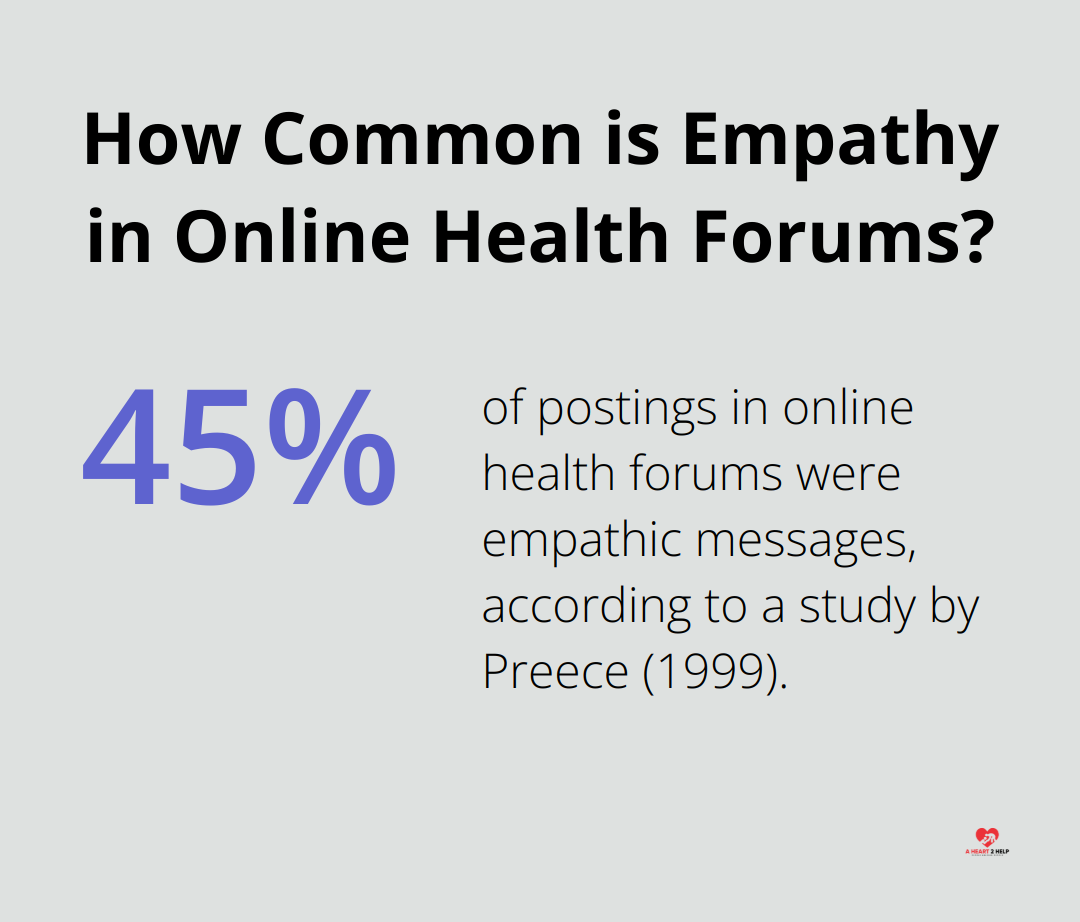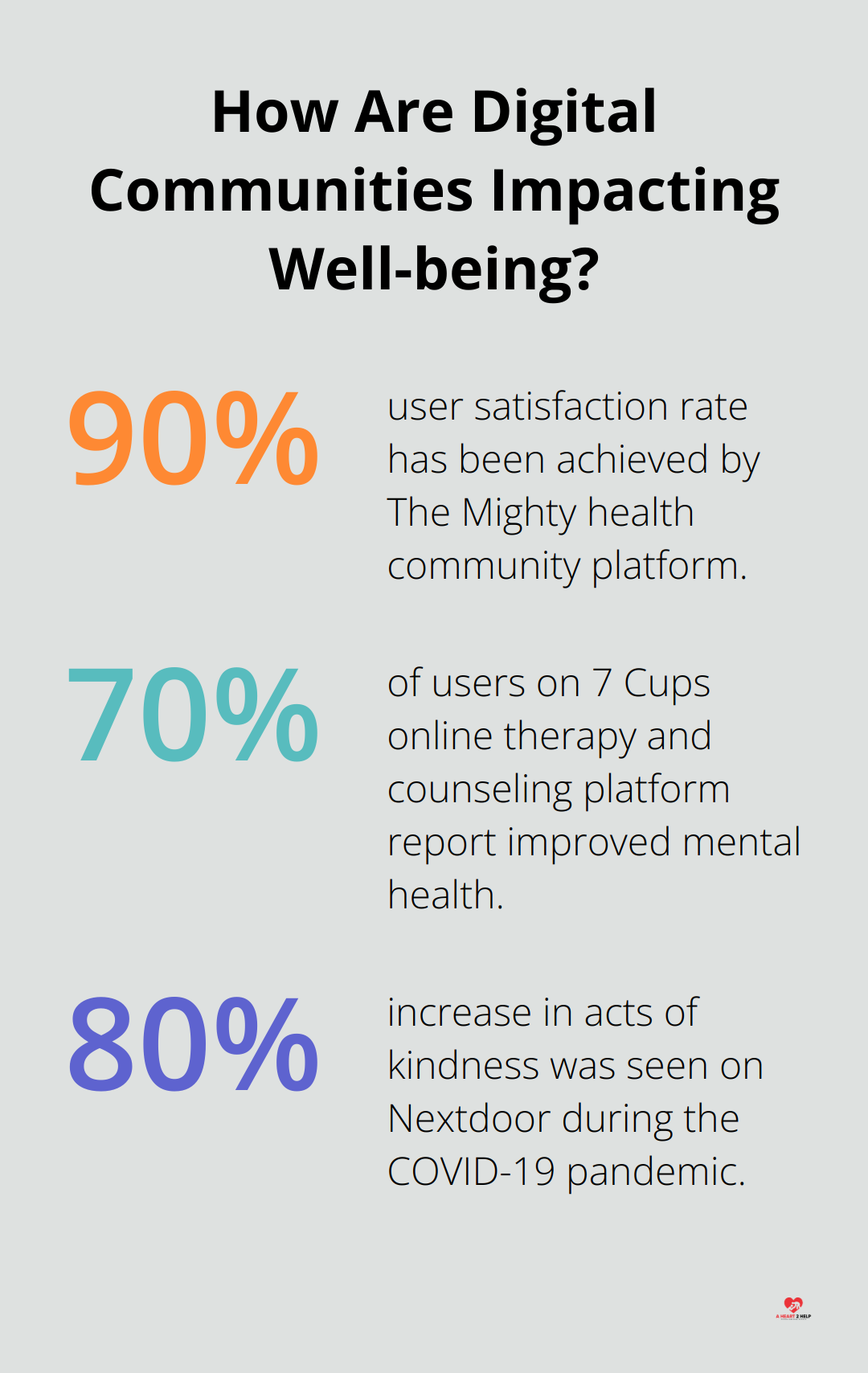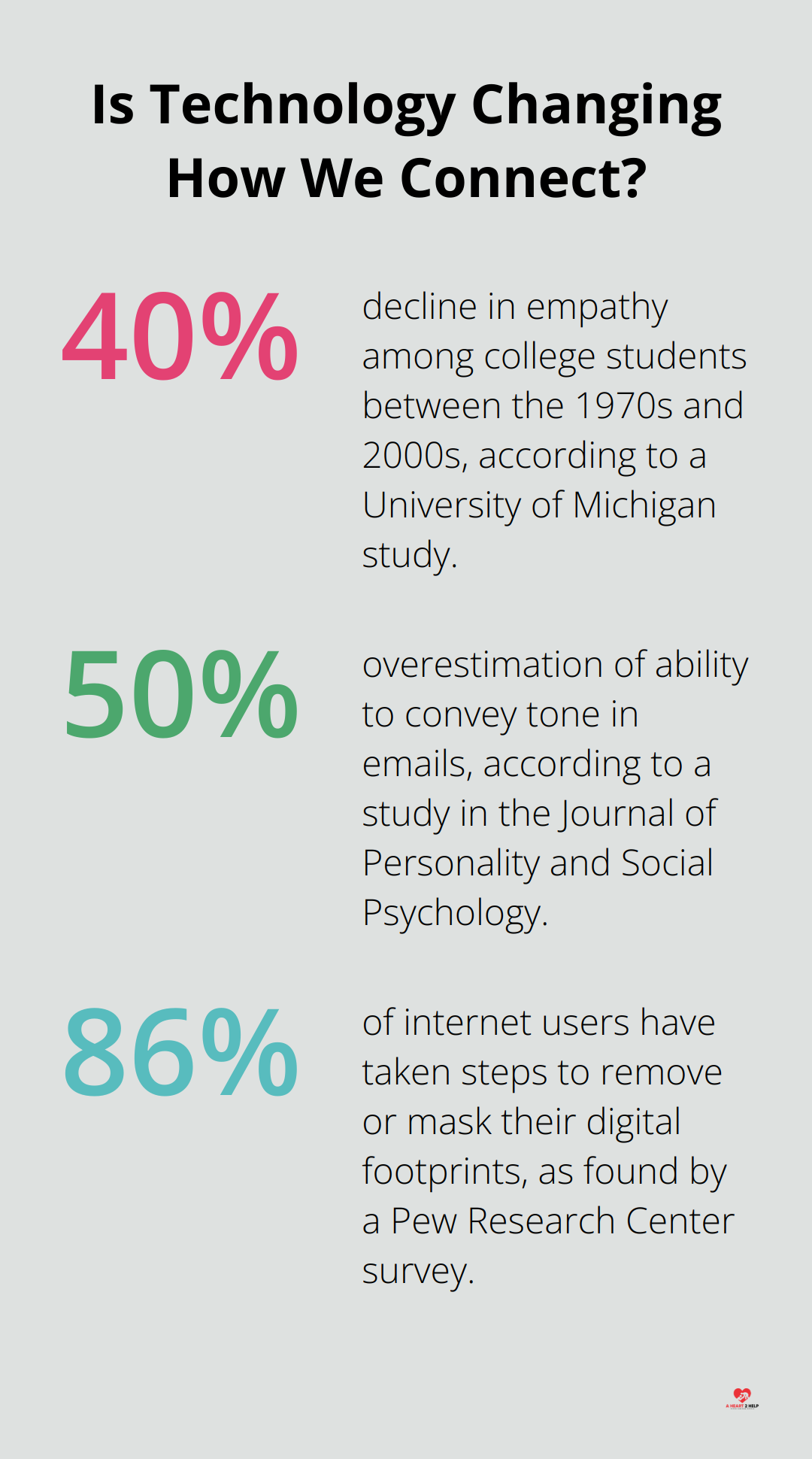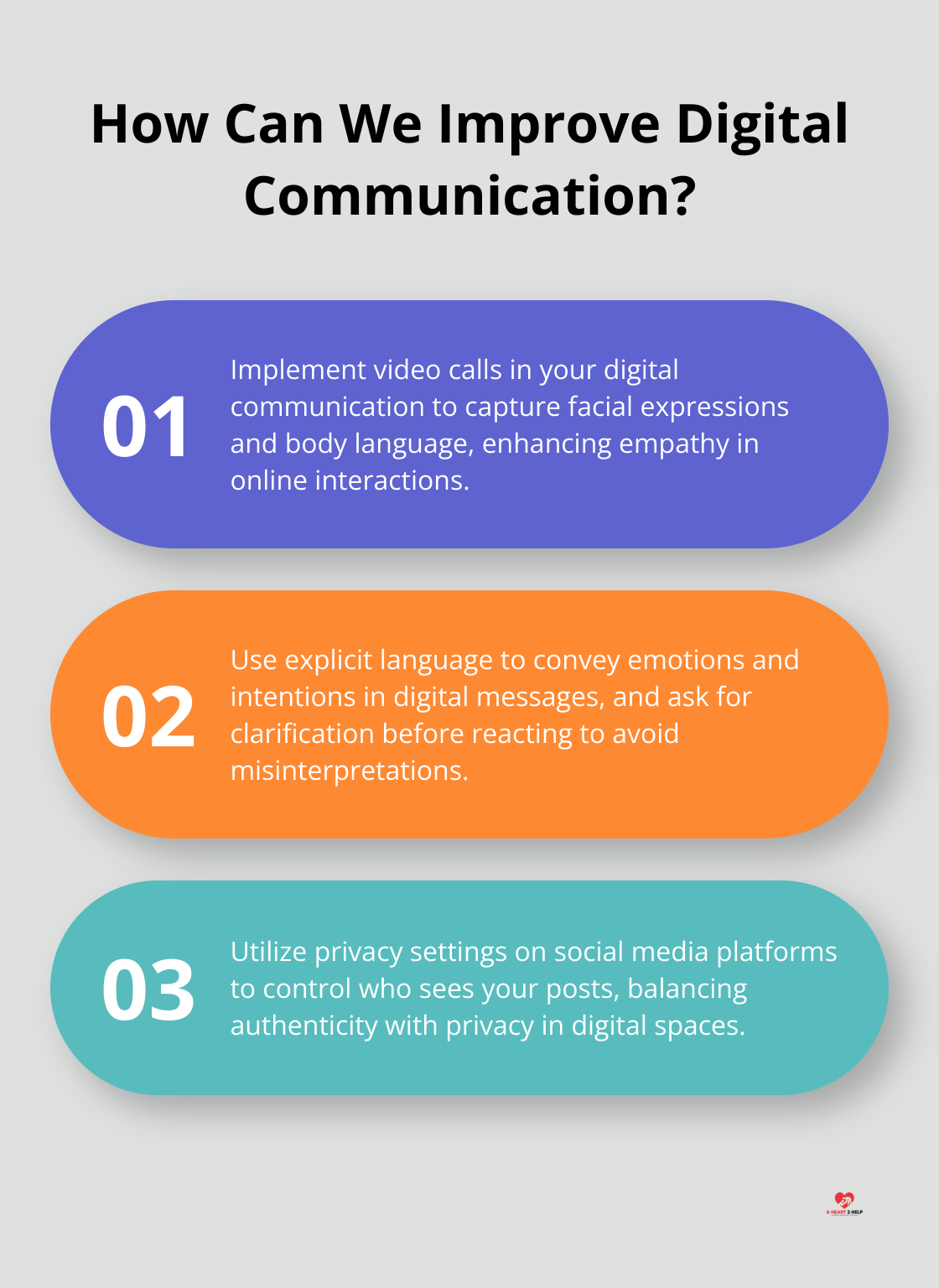In our increasingly digital world, the concept of virtual empathy is gaining traction. At A Heart 2 Help, we’ve observed how this powerful tool can transform online interactions and foster stronger digital communities.
As we explore the potential of virtual empathy, we’ll examine its impact on engagement, the challenges it faces, and the technologies that enable it. Join us as we uncover how empathy in the digital realm can shape the future of online connections.
What Is Virtual Empathy?
The Essence of Digital Compassion
Virtual empathy is the ability to understand and share the feelings of others in digital spaces. This skill transforms online interactions, creates deeper connections, and fosters supportive communities.

Studies show that empathy thrives in online health support communities. A study by Preece (1999) found that nearly 45% of postings in online health forums were empathic messages. This highlights the potential for meaningful emotional support in digital spaces.
Technology as an Empathy Enabler
Advancements in communication technology have opened new avenues for empathetic interactions. Video calls allow for face-to-face conversations regardless of physical distance. This visual element helps convey non-verbal cues, which are essential for empathetic understanding.
Social media platforms have also evolved to support more nuanced emotional expressions. Facebook’s reaction buttons go beyond simple likes to express a range of emotions (joy, sadness, anger, etc.), allowing users to respond more empathetically to posts.
Real-World Impact of Virtual Empathy
The Narrative 4 initiative (co-founded by author Colum McCann) demonstrates the power of virtual empathy. Their “Summer of Impact” program used online discussions to build empathy through storytelling, attracting a global audience.
Another powerful example comes from the Parents Circle – Families Forum. This group of over 600 families (affected by the Israeli-Palestinian conflict) uses online platforms to share stories and promote understanding rather than retaliation.
These examples show that virtual empathy isn’t just a concept – it’s a tool for real-world change. It fosters understanding and connection in digital spaces, which builds stronger, more supportive communities both online and offline.
The Potential of Empathy-Driven Technologies
As technology continues to advance, we see new tools emerge that enhance our ability to express empathy online. Virtual Reality (VR) experiences have the potential to promote better knowledge mastery and a higher level of empathy, providing a powerful medium for empathy building.
AI-powered chatbots are another emerging technology with the potential to provide empathetic support. These bots can be programmed to recognize emotional cues in text and respond with appropriate empathy, providing 24/7 support for those in need.
The rise of virtual empathy opens up exciting possibilities for building stronger digital communities. In the next section, we’ll explore how this powerful force can be harnessed to create more engaging and supportive online spaces.
How Empathy Transforms Digital Communities
The Engagement Power of Empathy
Empathy revolutionizes online interactions. It’s not just a feel-good concept; it’s a powerful tool for building stronger, more engaged digital communities. Empathy drives meaningful online engagement. When users feel understood and valued, they participate more actively in digital spaces. A recent study examined the relationship between social media use and empathy among 1253 American adults.

This increased engagement goes beyond more likes or comments. It leads to deeper, more authentic connections.
Empathy-Enhancing Tools and Platforms
Several platforms lead the charge in fostering empathetic online interactions:
- Empathy.co: This e-commerce search platform uses AI to understand user intent and emotion, providing more personalized and empathetic search experiences.
- Koko: A peer-to-peer support network that uses AI to route messages to the most appropriate responders, ensuring empathetic and helpful interactions.
- A Heart 2 Help: This app connects those in need with compassionate volunteers, fostering empathy through real-world actions and community support.
These tools create environments where empathy can flourish, leading to stronger, more supportive digital communities.
Success Stories: Empathy in Action
The power of empathy-driven communities shines through in several success stories:
- The Mighty: This health community platform has over 2 million registered users sharing stories and support. Their empathy-first approach has led to a 90% user satisfaction rate and countless stories of life-changing connections.
- 7 Cups: This online therapy and counseling platform uses trained listeners to provide empathetic support. They’ve facilitated over 50 million conversations, with 70% of users reporting improved mental health.
- Nextdoor: This neighborhood-focused social network saw an 80% increase in acts of kindness during the COVID-19 pandemic, demonstrating how digital empathy can translate to real-world impact.
These examples prove that empathy isn’t just a nice-to-have in digital spaces. It’s a fundamental building block for creating thriving, supportive online communities.
The Future of Empathy-Driven Communities
As technology advances, we can expect to see even more innovative ways to foster empathy in digital spaces. Virtual Reality experiences show promise in providing learners with access to authentic experiences and promoting empathetic learning. AI-powered chatbots (programmed to recognize emotional cues in text) could provide 24/7 empathetic support for those in need.
The role of empathy in shaping our online experiences cannot be overstated. It creates stronger, more resilient communities that extend far beyond the screen. However, fostering empathy in digital spaces comes with its own set of challenges. In the next section, we’ll explore these obstacles and discuss potential solutions for overcoming them.
The Challenges of Virtual Empathy
The Digital Empathy Gap
Virtual empathy faces significant hurdles in digital spaces. A 2010 study by the University of Michigan found that empathy among college students had declined 40% between the 1970s and the 2000s, with increased digital communication as a potential factor. This gap stems from the lack of non-verbal cues and physical presence in online interactions.

Users can bridge this gap by:
- Using video calls to capture facial expressions and body language
- Incorporating emojis and GIFs to convey tone and emotion in text-based communication
- Practicing active listening through paraphrasing and asking clarifying questions in online discussions
Misinterpretation in Virtual Environments
The absence of context and tone in digital communication often leads to misunderstandings. A study published in the Journal of Personality and Social Psychology found that people overestimate their ability to convey tone in emails by 50%.
To minimize misinterpretation, users should:
- Be explicit about emotions and intentions in digital messages
- Avoid sarcasm or humor that might not translate well in text
- Ask for clarification before reacting when in doubt
The Privacy Paradox
Balancing authenticity and privacy presents a significant challenge in digital spaces. Oversharing can lead to vulnerability, while being too guarded can prevent meaningful connections. A survey by the Pew Research Center found that 86% of internet users have taken steps to remove or mask their digital footprints.
To navigate this paradox, users can:
- Be selective about the personal information they share online
- Use privacy settings on social media platforms to control who sees their posts
- Consider using anonymous platforms for sensitive discussions
Overcoming Technological Limitations
While technology enables virtual empathy, it also imposes limitations. The lack of physical touch and presence can hinder the full expression of empathy. Additionally, internet connectivity issues and device limitations can disrupt empathetic moments.
To address these limitations, users can:
- Utilize high-quality audio and video tools for more immersive interactions
- Explore emerging technologies (such as haptic feedback devices) to enhance virtual connections
- Develop backup communication plans for when technology fails
Combating Online Disinhibition
The anonymity and distance provided by digital platforms can lead to a phenomenon known as online disinhibition. This can result in reduced empathy and increased negative behaviors (such as cyberbullying or trolling).
To combat online disinhibition, digital communities can:
- Implement clear community guidelines and moderation policies
- Encourage users to use real names and profile pictures (when appropriate)
- Foster a culture of accountability and respect within the community
These challenges, while significant, are not insurmountable. By acknowledging and addressing these issues, we can work towards creating more empathetic digital spaces. Effective collaboration in diverse teams relies on empathy as its cornerstone. Platforms like A Heart 2 Help lead the way by prioritizing user privacy while fostering collaboration and mutual support through real-world actions.
Final Thoughts
Virtual empathy transforms digital communities, fostering deeper connections across geographical boundaries. We anticipate advancements in virtual reality and AI-powered tools to enhance empathetic experiences online. The true potential of virtual empathy lies in our collective commitment to cultivating it in digital interactions.

As our world becomes increasingly interconnected, empathy in online spaces promotes understanding, respect, and mutual support. Platforms like A Heart 2 Help lead the way in harnessing the power of virtual empathy, connecting compassionate individuals with those in need. Their approach demonstrates how technology can foster real-world empathy and support.
We must remember that behind every screen is a real person with real emotions. Virtual empathy creates a more compassionate digital world that reflects the best of our shared humanity. The future of our digital communities depends on our ability to understand, connect, and support one another.
